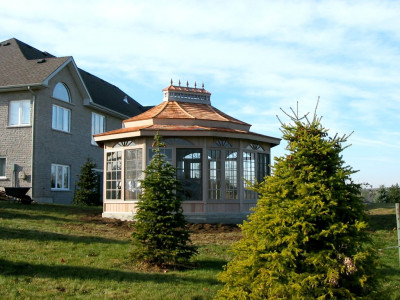
By Jason Cramp
They go by many names—gazebos, cabanas, cupolas, pergolas or pavilions—and are made out of everything from wood, metal and glass to fabric and composites. However, no matter what hot tub enclosures and their components are called or constructed of, these structures can help create an ideal backyard getaway—a home away from home.
Privacy and protection

Whether it is a cedar gazebo or a glass pergola, enclosures offer several benefits to both the hot tub itself and its owners. The main selling features of an enclosure are the protection they offer bathers from the elements, whether it is windy, raining or even snowing, and the privacy they provide from neighbours.
“Hot tub enclosures are entirely weather-proof, keeping out all elements, and they provide complete privacy,” says Casey Loyd, president of Cal Spas in Pomona, Calif. “As such, consumers are now looking for complete finished enclosures, rather than open-lattice designs.”
David Martin of Dundalk Enterprises in Dundalk, Ont., agrees.
“Most consumers prefer to have an enclosure that can be completely closed in, with the option to open it up,” he explains. “This can be done with sliding windows that have screens to protect bathers from insects, or by using a unique shutter system to allow air to circulate, while providing a high level of privacy.”
According to Martin, ‘The Islander,’ is the company’s most popular enclosure, which offers screened windows that can be opened on warm evenings or remain closed for comfort and privacy. An acrylic skylight allows bathers to sit back and gaze at the stars on quiet evenings with the family.
Go big or go home
A current trend manufacturers have noticed is the consumer’s preference for larger enclosures, which are essentially used as an additional living space. These sizeable structures provide room for outdoor gatherings and dining, or even a quiet place to read a book.
“Outdoor rooms are the biggest trends in the hot tub enclosure market because they add value to the home and can be used year round,” Loyd says.
For example, Cal Spas’ new ‘Tuscany’ enclosure, which is available in 3 x 3-m (10 x 10-ft) and 3.6 x 3.6-m (12 x 12-ft) footprints, is quickly gaining popularity, according to Loyd. A homeowner who adds this type of enclosure to their backyard gets the same results as if they added an entire room to their home, without adding to the home’s square footage.
Another recent design trend Martin has noticed is the increased number of enclosures with a tropical look.
“Palm thatch on gazebos brings the tropical feel to any backyard, a feeling we all enjoy,” he says. “We can’t all spend our vacations in the tropics, so why not in your backyard?”

Glass cupolas can offer the best of both worlds when it comes to extending the bathing season and providing additional living space. These enclosures often feature copper roofs and sliding screen windows, creating a focal point in the backyard. The ‘Glass House’ enclosure from Limestone Trail in Beamsville, Ont., has full horizontal, sliding screened windows, which allow breeze and natural light to filter through the room while keeping insects out.
“The primary hot tub enclosures in the past were the lip-mount style, or the kind that provided just enough room to get around the hot tub for service and maintenance purposes,” explains Wanda Searle, Limestone Trail’s sales administrator. “A glass cupola provides space for seating, with enough room for two or three chairs, including a bar fridge or even a small bar. Thus, a pleasant space can be created for family and friends to sit and visit, whether they wish to be in the hot tub or lounging nearby.”







Can you get the fully enclosed room without a floor in a custom size 11’9″ x 11’9″?